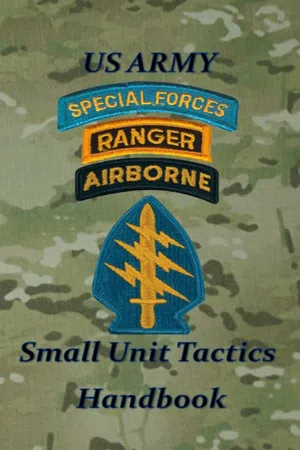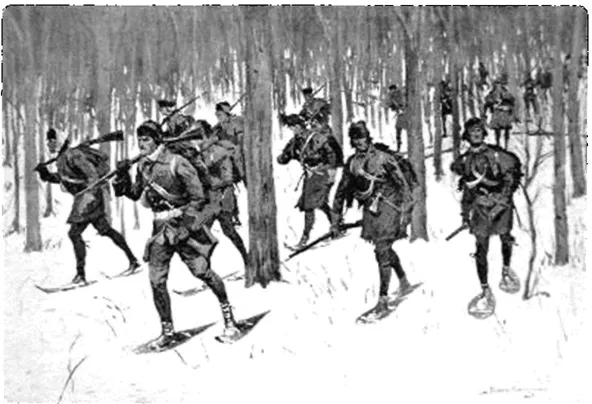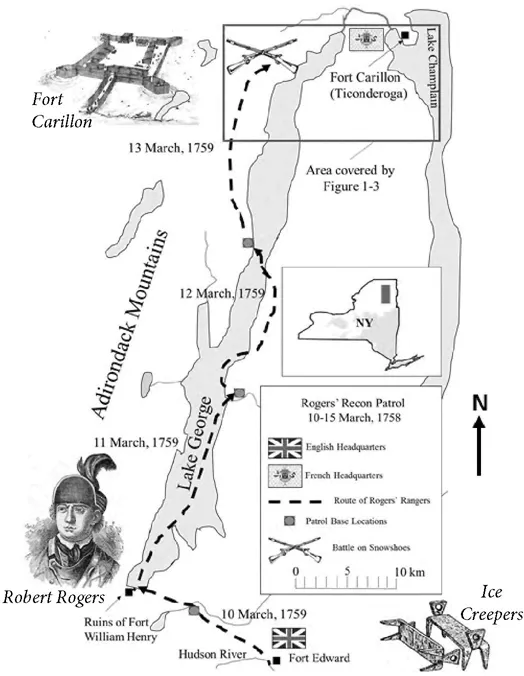
- English
- ePUB (mobile friendly)
- Available on iOS & Android
eBook - ePub
US Army Small Unit Tactics Handbook
About this book
A conceptual overview of all relevant topics of small unit tactics every soldier ought to be familiar with in order to be effective on today's battlefield. The handbook is categorized into five functional areas; history, doctrine, planning, operations, and common skills.
Frequently asked questions
Yes, you can cancel anytime from the Subscription tab in your account settings on the Perlego website. Your subscription will stay active until the end of your current billing period. Learn how to cancel your subscription.
No, books cannot be downloaded as external files, such as PDFs, for use outside of Perlego. However, you can download books within the Perlego app for offline reading on mobile or tablet. Learn more here.
Perlego offers two plans: Essential and Complete
- Essential is ideal for learners and professionals who enjoy exploring a wide range of subjects. Access the Essential Library with 800,000+ trusted titles and best-sellers across business, personal growth, and the humanities. Includes unlimited reading time and Standard Read Aloud voice.
- Complete: Perfect for advanced learners and researchers needing full, unrestricted access. Unlock 1.4M+ books across hundreds of subjects, including academic and specialized titles. The Complete Plan also includes advanced features like Premium Read Aloud and Research Assistant.
We are an online textbook subscription service, where you can get access to an entire online library for less than the price of a single book per month. With over 1 million books across 1000+ topics, we’ve got you covered! Learn more here.
Look out for the read-aloud symbol on your next book to see if you can listen to it. The read-aloud tool reads text aloud for you, highlighting the text as it is being read. You can pause it, speed it up and slow it down. Learn more here.
Yes! You can use the Perlego app on both iOS or Android devices to read anytime, anywhere — even offline. Perfect for commutes or when you’re on the go.
Please note we cannot support devices running on iOS 13 and Android 7 or earlier. Learn more about using the app.
Please note we cannot support devices running on iOS 13 and Android 7 or earlier. Learn more about using the app.
Yes, you can access US Army Small Unit Tactics Handbook by Paul D LeFavor in PDF and/or ePUB format, as well as other popular books in History & Military & Maritime History. We have over one million books available in our catalogue for you to explore.
Information
Part One:
Special Forces History
Special Forces History

Chapter 1
A Concise History of the Special Forces
A Concise History of the Special Forces
"To be ignorant of what occurred before you were born is to remain always a child. For what is the worth of human life, unless it is woven into the life of our ancestors by the records of history?" – Cicero
If there's one thing we don't learn from history, it's we don't learn from history. Therefore, if the study of history is to be meaningful then it must be interpreted. Moreover, because proud soldiers form the backbone of any successful military organization, a unit history is therefore invaluable to instilling a strong sense of pride.1 Likewise, as the ancient historian Polybius observed, "the most instructive method of learning, is to recall the catastrophes of others." Thus, a unit armed with a knowledge of itself, untrammeled with hagiographic drivel, and a wantonness to cover over its faults, fosters esprit de corps, and may, as it were, enable its progeny to stand, in a sense, upon the storied shoulders of their forebears, to see further afield, and draw from the annals of time matchless lessons, purchased with skill, determination, and self-sacrifice.
With that in mind, the intent of this study is to cover in broad terms the history of Special Forces from its historic progenitors and official inception, to the Global War on Terrorism (GWOT). The reader should understand that this is not intended as a comprehensive account of such a glorious subject, nor is it meant to be an operational history. Nevertheless, as a thumbnail sketch, this chapter seeks to convey to the student of war a conceptual overview of SF's historical roots, major campaigns and engagements. It is hoped that this short study will provide the reader with an enlightened perspective from which to assess the development of the First Special Forces Regiment (Airborne).
Special Forces can trace its origins by way of a heritage, a lineage, and a legacy. To begin with, Special Forces share a historical heritage with the 75th Ranger Regiment through storied elite units such as Rogers' Rangers. Additionally, Special Forces derives its lineage from the First Special Service Force (FSSF), which was a joint US – Canadian commando unit otherwise known as the 'Devil's Brigade.' Finally, the Special Forces Regiment follows the legacy of the Office of Strategic Services (OSS). For a graphic depiction of this line of thought, see Figure 1-1.

Figure 1-1. The Origins of the Special Forces Regiment.
Early Colonial Rangers
During the early Colonial days of America, the Colonists, without significant government support, successfully defended themselves against Indian attacks by organizing and employing Ranger companies. Benjamin Church (1639-1718), considered the father of American ranging, commanded the first Ranger force in America. Church was commissioned by Josiah Winslow, the Governor of Plymouth Colony, to organize, train, and lead the first Ranger Company during King Philip's War.2
Church sought men who were experienced in the woods and recruited both Native Americans and European settlers for his Ranger Company. Taking full advantage of the skills of both groups, Church prosecuted a successful war against King Philip (Metacomet) by conducting numerous ambushes and raids, culminating in Metacomet's death and an end of hostilities. Describing Church, Robert Black observes,
Benjamin Church was a towering figure on the early frontier. Like every other early American Ranger who wished to keep his hair, he learned to combine Indian tactics with European discipline and weaponry. Some eighty years before Robert Rogers wrote his ranging rules, Church was writing of the importance of not traveling the same route twice...he separated captives and questioned them individually...and attacked at night, with his men crawling on their bellies until close to the enemy. Church's lessons would serve the Rangers well in the years ahead.3
Church would later go on to lead his Rangers during the frontier wars which were fought between England and France. Church's Rangers became experts in reconnaissance and guerrilla warfare. Additionally, during King William's War (1688-1697), Church's Rangers developed a water-borne operations capability when John Gorham II of Massachusetts provided some fifty whaleboats which the Rangers used for infiltrations and coastal raids. The Gorham family had a long history of ranging with Benjamin Church. John Gorham I died while fighting alongside Church in the famous Great Swamp Fight of 1675. John Gorham II went on to range with Church during the expedition into Acadia (Canada), which involved the Raid on Chignecto in 1696 during King William's War, and in the summer of 1744, John Gorham III (1709-1751), took on the family mantle and began recruiting men for his own Ranger Company – Gorham's Rangers.
This company became one of the most famous and effective Ranger units raised in colonial North America. It served with distinction until it was disbanded in 1762. Like Church before him, Gorham recruited both Native American and European skilled frontiersmen. In the early days of Gorham's Rangers, the colonists learned guerrilla tactics from veteran Native American warriors, most of them being Wampanoag and Nauset Indians from Cape Cod. By acquiring these tactics, Gorham's Rangers could traverse great swaths of uncharted territory, strike deep into remote areas, and destroy the enemy with deadly ambushes and lightening raids.
When the French and Indian War erupted in 1754, Gorham's Rangers went on to play a prominent role under their new commander, Joseph Gorham (1725-1790), the brother of John Gorham III. Joseph had served as a lieutenant in his brother's company and was promoted to captain and took command after John's death in 1751. During the French and Indian War (1754-1763), Gorham's Rangers were highly prized guerrilla fighters who, in addition to their other exploits, prosecuted a successful counterinsurgency campaign against the Micmac Indians and rebel French Acadians. This led to the latter's expulsion from Nova Scotia. The success of Gorham's Rangers led to the creation of six additional ranger companies, one of which was Rogers' Rangers, led by Robert Rogers.
Rogers' Rangers
Of Scots-Irish descent, Robert Rogers (1731-1795) was born in the village of Methun in the Massachusetts Bay Colony. At the age of fourteen, he began to participate in scouting missions against the Indians, acquiring skills from experienced frontiersmen. In much the same way as Church and Gorham before him, Rogers took the initiative to organize, train and lead an elite guerrilla fighting force which became known as Rogers' Rangers. Impressed with the Rangers' capabilities, Rogers' superiors authorized the augmentation of his company to include five more companies. Each Ranger company consisted of one captain, two lieutenants, one ensign, four sergeants, and one hundred privates. Rogers served as both the commandant and commander of his own company.
Rogers' patrols were not for the weak or fainthearted. On one such patrol, on 10 March, 1758, Rogers led a band of 184 Rangers and regulars out of Rogers' Island to scout French positions in the vicinity of Fort Carillon – Ticonderoga (Figure 1-2).

Figure 1-2. Rogers' Reconnaissance Patrol of 10-16 March, 1758
Rogers' force wore snow shoes and trudged through snow that at times was up to four feet deep. On the second day of the patrol, the Rangers marched passed the burnt out ruins of Fort William Henry, and then by wearing ice creepers on their feet, they proceeded north making their way across the frozen surface of the lake.
On the third day of the patrol (13 March), Rogers had his men don their snowshoes and proceed toward Fort Carillon along the west bank of Lake George. Early on 13 March, the French commander at Fort Carillon, Captain d'Hébécourt, having been alerted to the English movement, sent Ensign Durantaye with 100 men (a mixed force of Indians and Canadian marines) to intercept Rogers. Later, d'Hébécourt sent out a larger force of some 200-300 Indians under Ensign de Langy in support.4 By 1500 hours on 13 March, Rogers' force had approached to within three miles of Fort Carillon when his scouts reported an enemy patrol of about 100 men (Durantaye's force) advancing up the frozen Trout Brook near his position (Figure 1-3).

Figure 1-3. Battle on Snowshoes 13 March, 1758
Rogers immediately directed his men to drop packs, and taking up an ambush position, directed his men to stretch out their line along the high ground just opposite of the brook. Unbeknownst to Rogers, about 100 meters behind Durantaye was Langy's force in trail. Lying in wait, Rogers allowed the enemy force to advance until "their front was nearly opposite our left-wing," then, discharging his musket, he unleashed an eruption of murderous fire which, according to him, mowed down forty or so Indians.5
Durantaye's force broke and retreated in disarray. Those who tried to escape were cut down with tomahawks and knives as Rogers and about half his men gave chase, scalping another forty. Rogers recounts, "I now imagined the enemy totally defeated and ordered a pursuit that none may escape, but we soon found our mistake."6 And having failed to reload their muskets, Rogers' force ran straight into Langy's men, who alerted by the gunfire, set up their own ambush which produced equally devastating results; nearly decimating the Rangers.
Countering the French attack, Rogers ordered his remaining Rangers to fall back toward the high ground. There the remnants of his force fought on tenaciously as they continued to retreat up Bald Mountain. For over an hour the Rangers managed to keep themselves from being encircled. During this retreat, Rogers reportedly lost another 40 of his men. Describing the melee, Robert Black writes, "The Rangers fought a desperate delaying action, fighting from behind snow-covered rocks and trees. Clouds of powder smoke rolled over the battlefield as men screamed, cursed, and died. The fighting was hand-to-hand with the late afternoon sun glinting along the honed edge of tomahawks until the cold metal shine was dulled by blood."7
As the French pressed their attack, they drove the Rangers up the face of Bald Mountain. It was during this time, Rogers' tells us, that he lost an additional 108 men.8 With darkness rapidly approaching, and his numbers quickly dwindling, Rogers ordered his Rangers to break contact in order to avoid capture. Few managed to escape, and when one group surrendered, they were promptly scalped and killed when a scalp was discovered in one of their pockets.
Undaunted, Rogers narrowly avoided capture and rallied his remaining...
Table of contents
- Cover
- Title Page
- Dedication
- Copyright Page
- Contents
- Foreword
- Preface
- Special Forces Creed
- Ranger Creed
- A Soldier's Promise
- The Special Forces Prayer
- Part One: History
- Part Two: Doctrine
- Part Three: Planning
- Part Four: Operations
- Part Five: Common Skills
- Annexes
- Index